Business Decision Analytics Report: Executive Summary and Analysis
VerifiedAdded on 2021/12/28
|11
|3117
|34
Report
AI Summary
This report provides an executive summary and analysis of two business scenarios using business decision analytics. Scenario A explores an Australian organization's use of cluster analysis to identify key members for a meeting focused on innovation and creative capabilities, leveraging email communication data to map connections and select participants. Scenario B examines another Australian organization and utilizes Leximancer concept mapping to analyze communication between field staff, managers, and customers, highlighting the importance of communication, management, and customer relations for achieving business goals. The report recommends improved communication strategies, emphasizes the significance of customer relationships, and underscores the role of management in supporting team members to achieve organizational objectives. It suggests that organizations should prioritize clear communication, focus on customer satisfaction, and foster a supportive environment for employees to drive success.
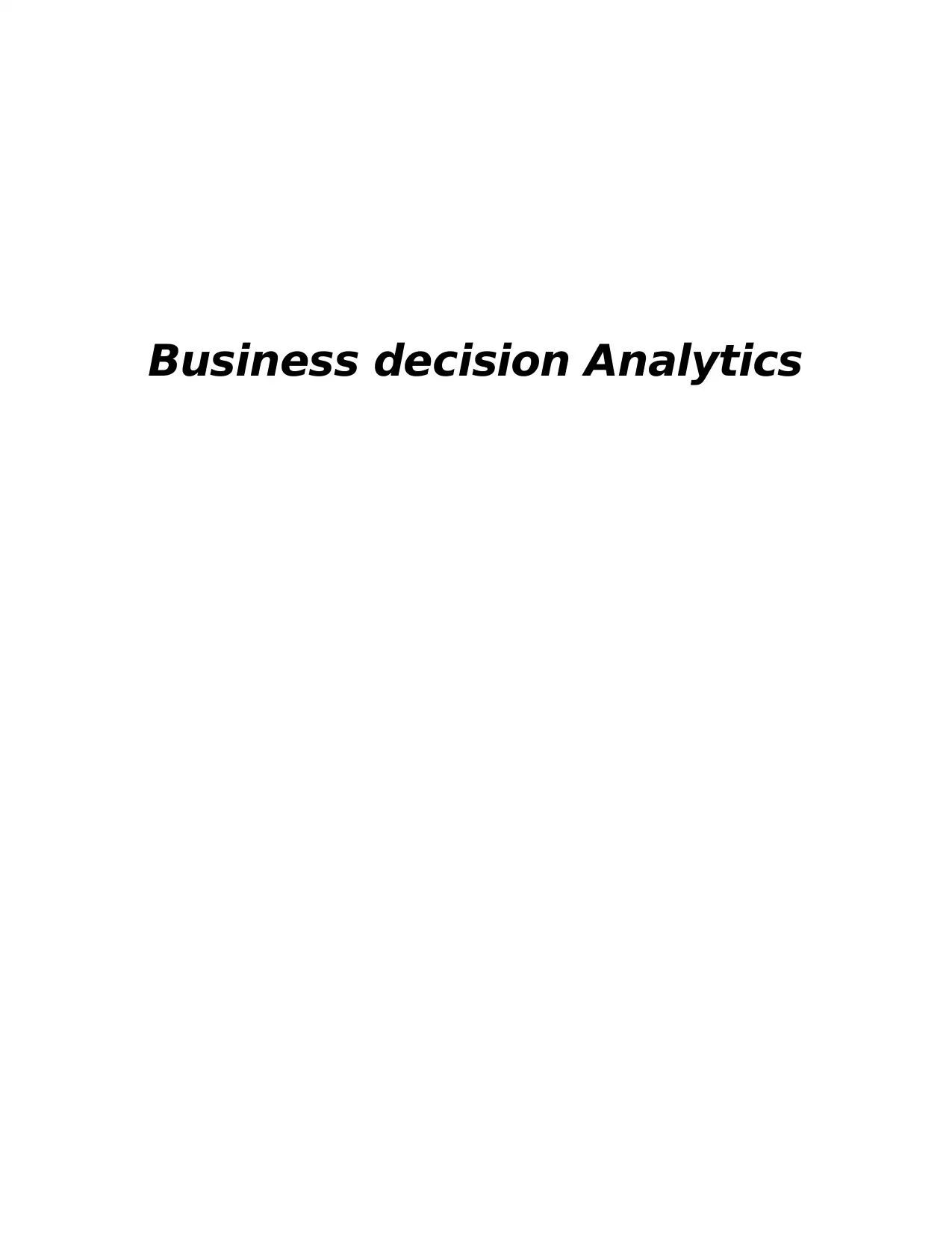
Business decision Analytics
Paraphrase This Document
Need a fresh take? Get an instant paraphrase of this document with our AI Paraphraser
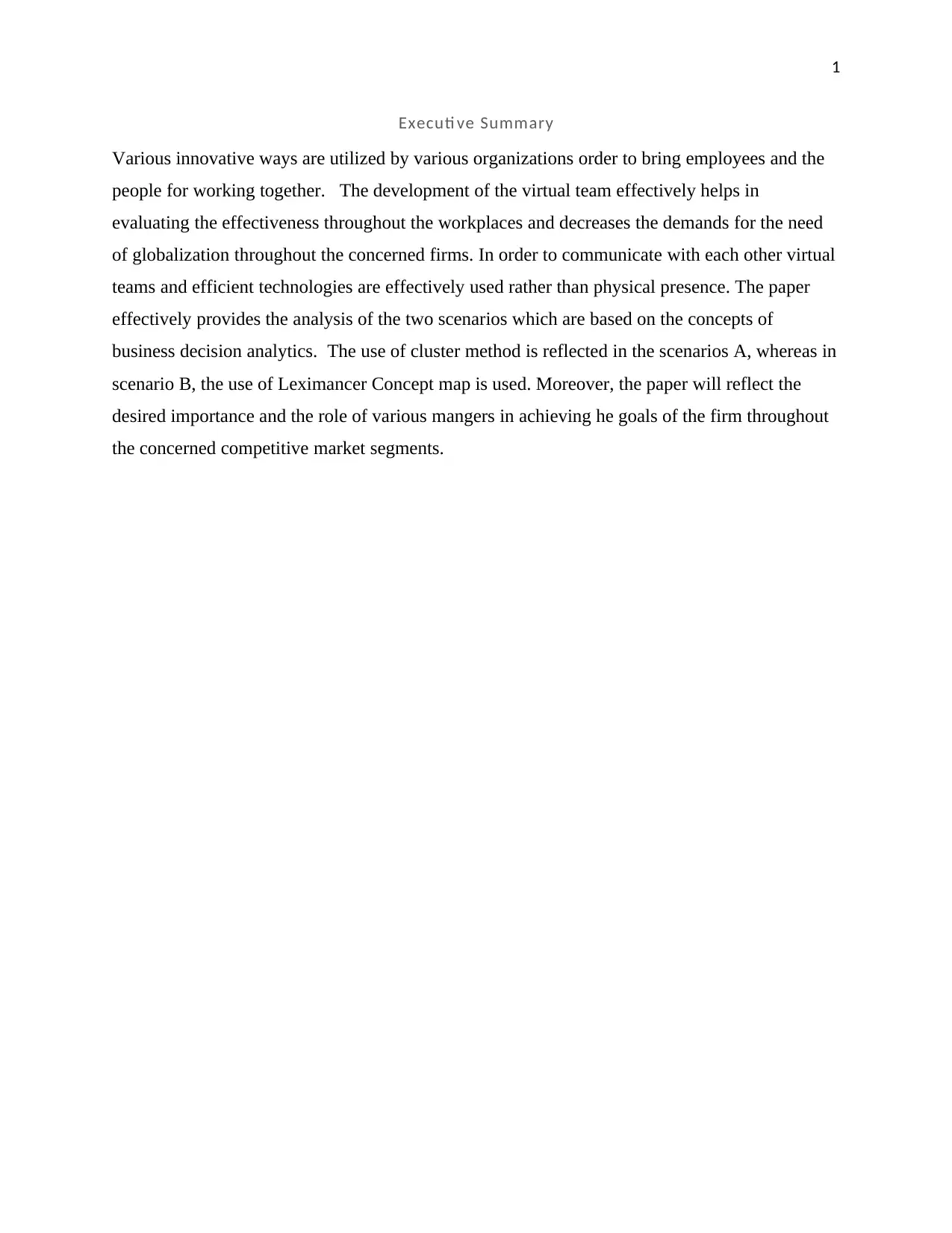
1
Executi ve Summary
Various innovative ways are utilized by various organizations order to bring employees and the
people for working together. The development of the virtual team effectively helps in
evaluating the effectiveness throughout the workplaces and decreases the demands for the need
of globalization throughout the concerned firms. In order to communicate with each other virtual
teams and efficient technologies are effectively used rather than physical presence. The paper
effectively provides the analysis of the two scenarios which are based on the concepts of
business decision analytics. The use of cluster method is reflected in the scenarios A, whereas in
scenario B, the use of Leximancer Concept map is used. Moreover, the paper will reflect the
desired importance and the role of various mangers in achieving he goals of the firm throughout
the concerned competitive market segments.
Executi ve Summary
Various innovative ways are utilized by various organizations order to bring employees and the
people for working together. The development of the virtual team effectively helps in
evaluating the effectiveness throughout the workplaces and decreases the demands for the need
of globalization throughout the concerned firms. In order to communicate with each other virtual
teams and efficient technologies are effectively used rather than physical presence. The paper
effectively provides the analysis of the two scenarios which are based on the concepts of
business decision analytics. The use of cluster method is reflected in the scenarios A, whereas in
scenario B, the use of Leximancer Concept map is used. Moreover, the paper will reflect the
desired importance and the role of various mangers in achieving he goals of the firm throughout
the concerned competitive market segments.
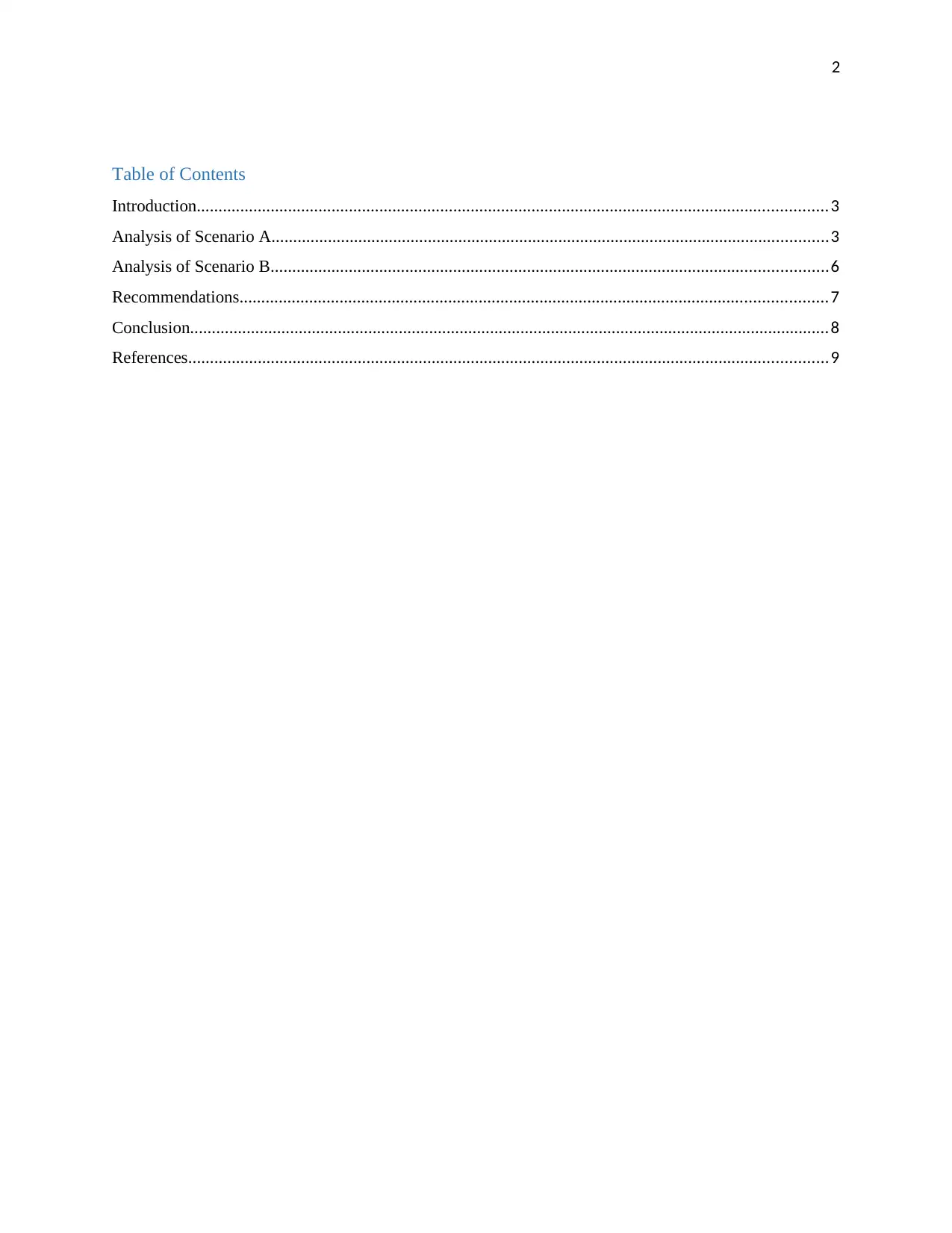
2
Table of Contents
Introduction.................................................................................................................................................3
Analysis of Scenario A................................................................................................................................3
Analysis of Scenario B................................................................................................................................6
Recommendations.......................................................................................................................................7
Conclusion...................................................................................................................................................8
References...................................................................................................................................................9
Table of Contents
Introduction.................................................................................................................................................3
Analysis of Scenario A................................................................................................................................3
Analysis of Scenario B................................................................................................................................6
Recommendations.......................................................................................................................................7
Conclusion...................................................................................................................................................8
References...................................................................................................................................................9
⊘ This is a preview!⊘
Do you want full access?
Subscribe today to unlock all pages.

Trusted by 1+ million students worldwide
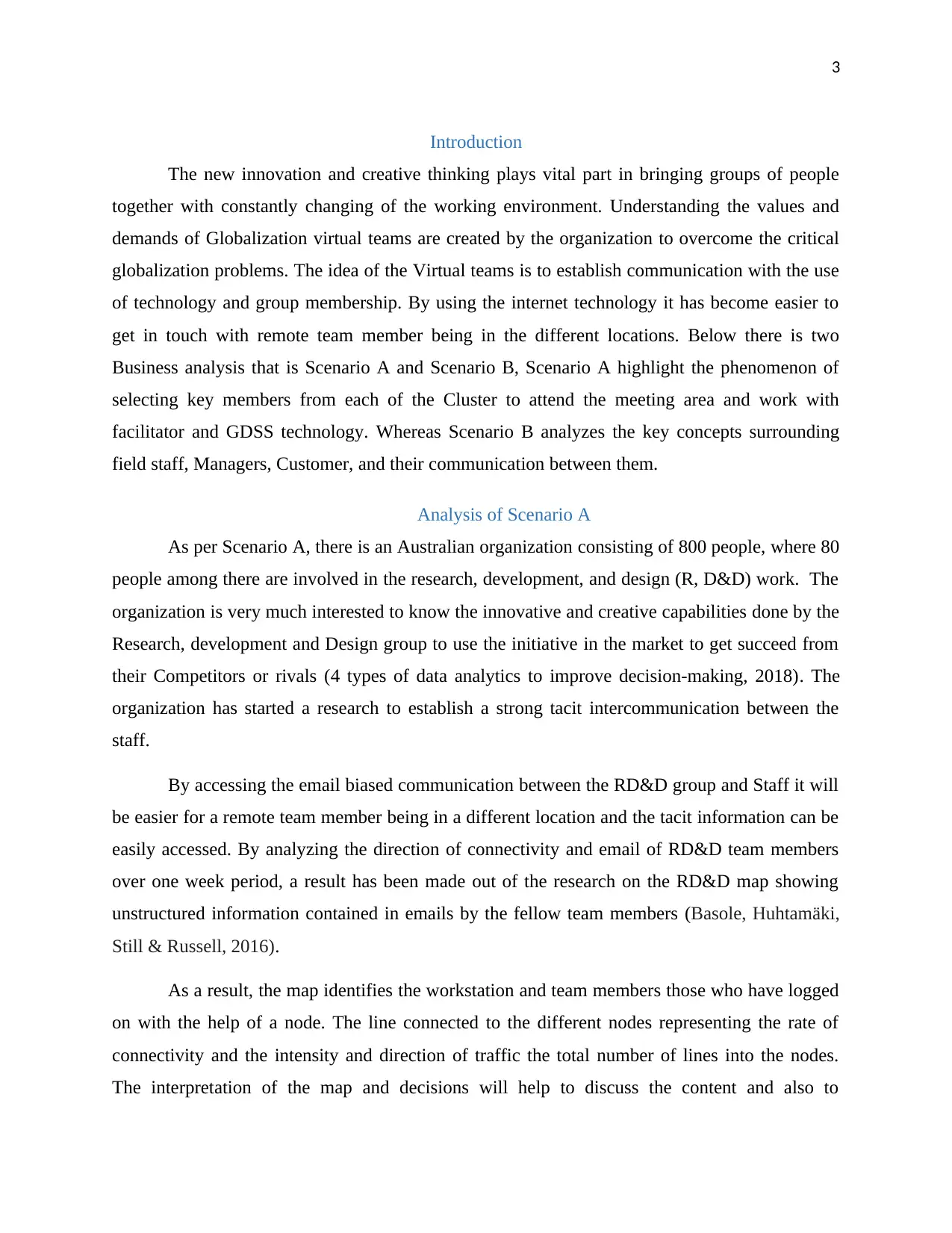
3
Introduction
The new innovation and creative thinking plays vital part in bringing groups of people
together with constantly changing of the working environment. Understanding the values and
demands of Globalization virtual teams are created by the organization to overcome the critical
globalization problems. The idea of the Virtual teams is to establish communication with the use
of technology and group membership. By using the internet technology it has become easier to
get in touch with remote team member being in the different locations. Below there is two
Business analysis that is Scenario A and Scenario B, Scenario A highlight the phenomenon of
selecting key members from each of the Cluster to attend the meeting area and work with
facilitator and GDSS technology. Whereas Scenario B analyzes the key concepts surrounding
field staff, Managers, Customer, and their communication between them.
Analysis of Scenario A
As per Scenario A, there is an Australian organization consisting of 800 people, where 80
people among there are involved in the research, development, and design (R, D&D) work. The
organization is very much interested to know the innovative and creative capabilities done by the
Research, development and Design group to use the initiative in the market to get succeed from
their Competitors or rivals (4 types of data analytics to improve decision-making, 2018). The
organization has started a research to establish a strong tacit intercommunication between the
staff.
By accessing the email biased communication between the RD&D group and Staff it will
be easier for a remote team member being in a different location and the tacit information can be
easily accessed. By analyzing the direction of connectivity and email of RD&D team members
over one week period, a result has been made out of the research on the RD&D map showing
unstructured information contained in emails by the fellow team members (Basole, Huhtamäki,
Still & Russell, 2016).
As a result, the map identifies the workstation and team members those who have logged
on with the help of a node. The line connected to the different nodes representing the rate of
connectivity and the intensity and direction of traffic the total number of lines into the nodes.
The interpretation of the map and decisions will help to discuss the content and also to
Introduction
The new innovation and creative thinking plays vital part in bringing groups of people
together with constantly changing of the working environment. Understanding the values and
demands of Globalization virtual teams are created by the organization to overcome the critical
globalization problems. The idea of the Virtual teams is to establish communication with the use
of technology and group membership. By using the internet technology it has become easier to
get in touch with remote team member being in the different locations. Below there is two
Business analysis that is Scenario A and Scenario B, Scenario A highlight the phenomenon of
selecting key members from each of the Cluster to attend the meeting area and work with
facilitator and GDSS technology. Whereas Scenario B analyzes the key concepts surrounding
field staff, Managers, Customer, and their communication between them.
Analysis of Scenario A
As per Scenario A, there is an Australian organization consisting of 800 people, where 80
people among there are involved in the research, development, and design (R, D&D) work. The
organization is very much interested to know the innovative and creative capabilities done by the
Research, development and Design group to use the initiative in the market to get succeed from
their Competitors or rivals (4 types of data analytics to improve decision-making, 2018). The
organization has started a research to establish a strong tacit intercommunication between the
staff.
By accessing the email biased communication between the RD&D group and Staff it will
be easier for a remote team member being in a different location and the tacit information can be
easily accessed. By analyzing the direction of connectivity and email of RD&D team members
over one week period, a result has been made out of the research on the RD&D map showing
unstructured information contained in emails by the fellow team members (Basole, Huhtamäki,
Still & Russell, 2016).
As a result, the map identifies the workstation and team members those who have logged
on with the help of a node. The line connected to the different nodes representing the rate of
connectivity and the intensity and direction of traffic the total number of lines into the nodes.
The interpretation of the map and decisions will help to discuss the content and also to
Paraphrase This Document
Need a fresh take? Get an instant paraphrase of this document with our AI Paraphraser

4
collaborate for doing tacit unstructured information taken from the mails which is suitable for the
organization (García-Peñalvo & Conde, 2014). By providing the different meeting room,
facilitator, visual aids with group discussion support system to the chosen team members of the
RD&D group will summarize the meeting room output.
Within the research, there will be a use of a group based communication technology
system to promote meeting and to help the staff members to create tacit information explicitly.
While the process it is very important that each group member should cooperate with one
another and also to provide a group guide process to ensure the collaboration.
The given below table highlight the six Cluster and Nodes as per cluster from the
Research, Development & design (RD&D) group who are chosen for the group meeting.
SR/NO Clusters Nodes as per cluster
1 15 6
2 39 4
3 31 4
4 74 11
5 04 5
6 45 5
The second table below shows the key members of RD&D staffs who are chosen for the
meeting according to their meeting room and cluster.
Rooms Cluster
Key members selected to
attend meetings
A 1 Assistance Manager
B 2 Research members
collaborate for doing tacit unstructured information taken from the mails which is suitable for the
organization (García-Peñalvo & Conde, 2014). By providing the different meeting room,
facilitator, visual aids with group discussion support system to the chosen team members of the
RD&D group will summarize the meeting room output.
Within the research, there will be a use of a group based communication technology
system to promote meeting and to help the staff members to create tacit information explicitly.
While the process it is very important that each group member should cooperate with one
another and also to provide a group guide process to ensure the collaboration.
The given below table highlight the six Cluster and Nodes as per cluster from the
Research, Development & design (RD&D) group who are chosen for the group meeting.
SR/NO Clusters Nodes as per cluster
1 15 6
2 39 4
3 31 4
4 74 11
5 04 5
6 45 5
The second table below shows the key members of RD&D staffs who are chosen for the
meeting according to their meeting room and cluster.
Rooms Cluster
Key members selected to
attend meetings
A 1 Assistance Manager
B 2 Research members
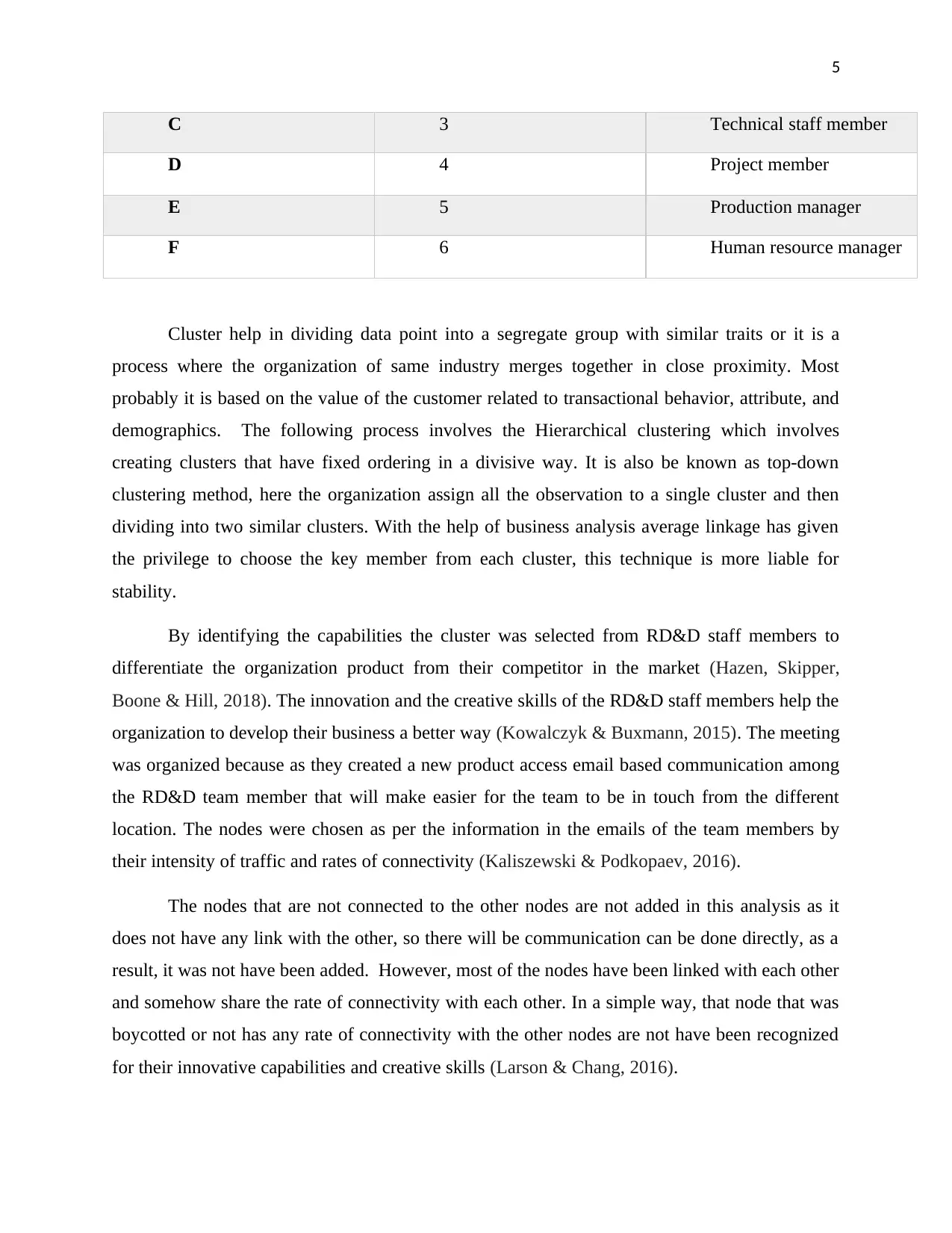
5
C 3 Technical staff member
D 4 Project member
E 5 Production manager
F 6 Human resource manager
Cluster help in dividing data point into a segregate group with similar traits or it is a
process where the organization of same industry merges together in close proximity. Most
probably it is based on the value of the customer related to transactional behavior, attribute, and
demographics. The following process involves the Hierarchical clustering which involves
creating clusters that have fixed ordering in a divisive way. It is also be known as top-down
clustering method, here the organization assign all the observation to a single cluster and then
dividing into two similar clusters. With the help of business analysis average linkage has given
the privilege to choose the key member from each cluster, this technique is more liable for
stability.
By identifying the capabilities the cluster was selected from RD&D staff members to
differentiate the organization product from their competitor in the market (Hazen, Skipper,
Boone & Hill, 2018). The innovation and the creative skills of the RD&D staff members help the
organization to develop their business a better way (Kowalczyk & Buxmann, 2015). The meeting
was organized because as they created a new product access email based communication among
the RD&D team member that will make easier for the team to be in touch from the different
location. The nodes were chosen as per the information in the emails of the team members by
their intensity of traffic and rates of connectivity (Kaliszewski & Podkopaev, 2016).
The nodes that are not connected to the other nodes are not added in this analysis as it
does not have any link with the other, so there will be communication can be done directly, as a
result, it was not have been added. However, most of the nodes have been linked with each other
and somehow share the rate of connectivity with each other. In a simple way, that node that was
boycotted or not has any rate of connectivity with the other nodes are not have been recognized
for their innovative capabilities and creative skills (Larson & Chang, 2016).
C 3 Technical staff member
D 4 Project member
E 5 Production manager
F 6 Human resource manager
Cluster help in dividing data point into a segregate group with similar traits or it is a
process where the organization of same industry merges together in close proximity. Most
probably it is based on the value of the customer related to transactional behavior, attribute, and
demographics. The following process involves the Hierarchical clustering which involves
creating clusters that have fixed ordering in a divisive way. It is also be known as top-down
clustering method, here the organization assign all the observation to a single cluster and then
dividing into two similar clusters. With the help of business analysis average linkage has given
the privilege to choose the key member from each cluster, this technique is more liable for
stability.
By identifying the capabilities the cluster was selected from RD&D staff members to
differentiate the organization product from their competitor in the market (Hazen, Skipper,
Boone & Hill, 2018). The innovation and the creative skills of the RD&D staff members help the
organization to develop their business a better way (Kowalczyk & Buxmann, 2015). The meeting
was organized because as they created a new product access email based communication among
the RD&D team member that will make easier for the team to be in touch from the different
location. The nodes were chosen as per the information in the emails of the team members by
their intensity of traffic and rates of connectivity (Kaliszewski & Podkopaev, 2016).
The nodes that are not connected to the other nodes are not added in this analysis as it
does not have any link with the other, so there will be communication can be done directly, as a
result, it was not have been added. However, most of the nodes have been linked with each other
and somehow share the rate of connectivity with each other. In a simple way, that node that was
boycotted or not has any rate of connectivity with the other nodes are not have been recognized
for their innovative capabilities and creative skills (Larson & Chang, 2016).
⊘ This is a preview!⊘
Do you want full access?
Subscribe today to unlock all pages.

Trusted by 1+ million students worldwide

6
For example, in this business analysis, the research members and the technical members
have been chosen for the meeting because skills and innovation are liked to one another. Their
jobs are inter-related to each other that's why they have been called for the meeting and also
same here for other team members too.
Analysis of Scenario B
In the given scenario there is an Australian wide service-based organization, the head
office is in Melbourne with consisting 200 service staff, 10 service centers, and with 40
managers. The organization provides the high quality of customer services by their staff and
started a project to analyze, what it means to a service person and also to identify the support
provided by the management.
Anaximander process is a qualitative analysis of tools of creating a sense of the vast
amount of data, it can also be used as a tool for deep analysis of a large amount of textual data.
The given map shows the relation between concepts that size, lines, and placement, it highlights
the six themes that are management, open, focused, communication, customer, and results
(Moro, Cortez & Rita, 2015). All these significant points and keywords play a vital role in
developing and executing business. In the map, all the balloons such as customer, open,
management, and result are connected with the communication balloon. By this analysis, it
seems clear the analysis of communication plays the most important part in developing and
executing the business.
According to the Leximanser concept, the map is showing that all the balloons are
interconnected to the communication balloon, which implies that communication balloon is
much important rather than others. The Focused balloon is attached to none of the balloons
which means that it is not much important as others however the Australian organization is
focused on the efficiency to give the better customer service.
Effective communication is one of the vital points for business, communication skill is a
building block to the successful organization it helps to plan, organizing, leading, and
controlling. It is a source of information to the organizational members in the sense of decision-
making process and it also promotes motivation (Nerkar, 2016). Communication also plays the
role in controlling the organization process, it used to control organizational member's behavior
For example, in this business analysis, the research members and the technical members
have been chosen for the meeting because skills and innovation are liked to one another. Their
jobs are inter-related to each other that's why they have been called for the meeting and also
same here for other team members too.
Analysis of Scenario B
In the given scenario there is an Australian wide service-based organization, the head
office is in Melbourne with consisting 200 service staff, 10 service centers, and with 40
managers. The organization provides the high quality of customer services by their staff and
started a project to analyze, what it means to a service person and also to identify the support
provided by the management.
Anaximander process is a qualitative analysis of tools of creating a sense of the vast
amount of data, it can also be used as a tool for deep analysis of a large amount of textual data.
The given map shows the relation between concepts that size, lines, and placement, it highlights
the six themes that are management, open, focused, communication, customer, and results
(Moro, Cortez & Rita, 2015). All these significant points and keywords play a vital role in
developing and executing business. In the map, all the balloons such as customer, open,
management, and result are connected with the communication balloon. By this analysis, it
seems clear the analysis of communication plays the most important part in developing and
executing the business.
According to the Leximanser concept, the map is showing that all the balloons are
interconnected to the communication balloon, which implies that communication balloon is
much important rather than others. The Focused balloon is attached to none of the balloons
which means that it is not much important as others however the Australian organization is
focused on the efficiency to give the better customer service.
Effective communication is one of the vital points for business, communication skill is a
building block to the successful organization it helps to plan, organizing, leading, and
controlling. It is a source of information to the organizational members in the sense of decision-
making process and it also promotes motivation (Nerkar, 2016). Communication also plays the
role in controlling the organization process, it used to control organizational member's behavior
Paraphrase This Document
Need a fresh take? Get an instant paraphrase of this document with our AI Paraphraser
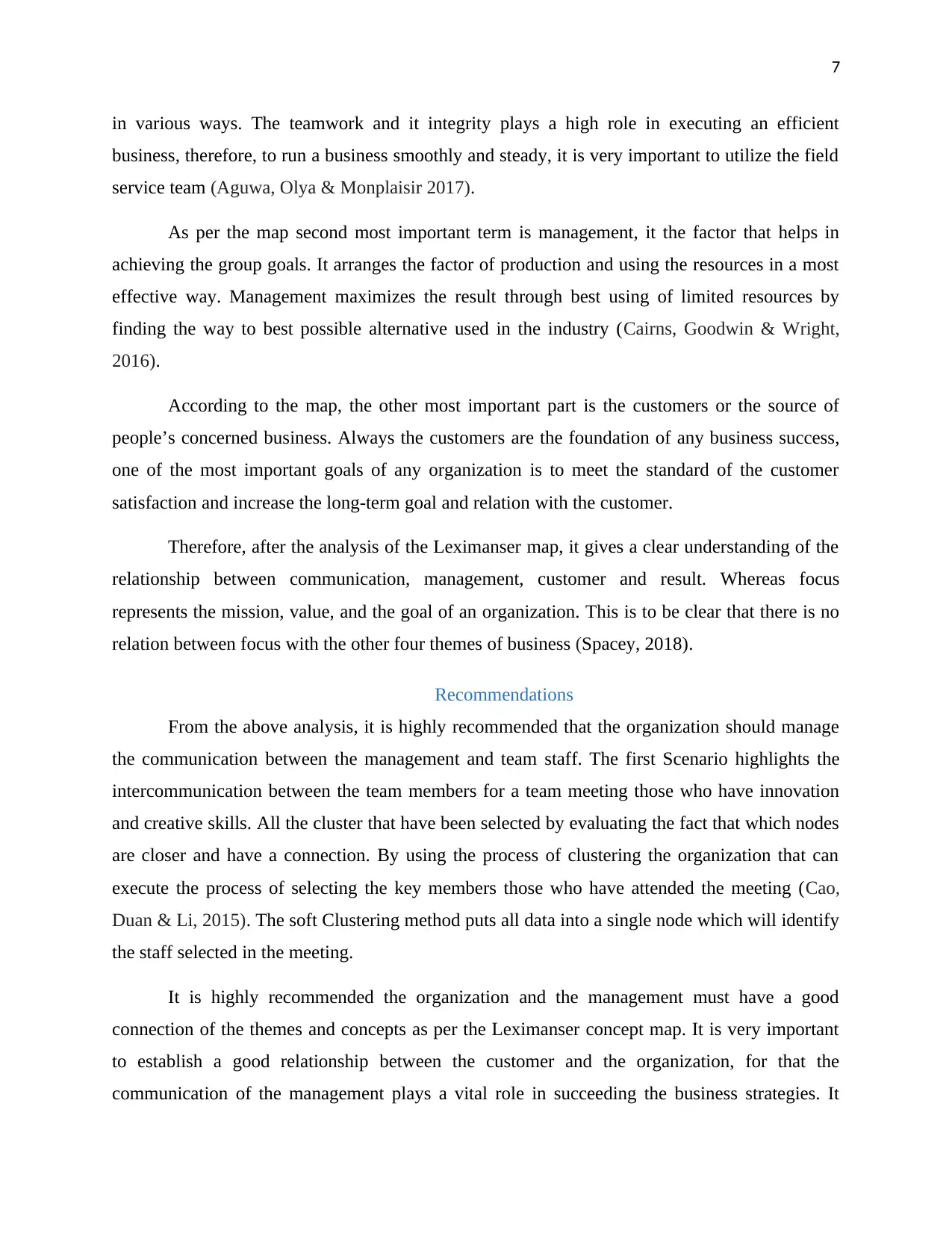
7
in various ways. The teamwork and it integrity plays a high role in executing an efficient
business, therefore, to run a business smoothly and steady, it is very important to utilize the field
service team (Aguwa, Olya & Monplaisir 2017).
As per the map second most important term is management, it the factor that helps in
achieving the group goals. It arranges the factor of production and using the resources in a most
effective way. Management maximizes the result through best using of limited resources by
finding the way to best possible alternative used in the industry (Cairns, Goodwin & Wright,
2016).
According to the map, the other most important part is the customers or the source of
people’s concerned business. Always the customers are the foundation of any business success,
one of the most important goals of any organization is to meet the standard of the customer
satisfaction and increase the long-term goal and relation with the customer.
Therefore, after the analysis of the Leximanser map, it gives a clear understanding of the
relationship between communication, management, customer and result. Whereas focus
represents the mission, value, and the goal of an organization. This is to be clear that there is no
relation between focus with the other four themes of business (Spacey, 2018).
Recommendations
From the above analysis, it is highly recommended that the organization should manage
the communication between the management and team staff. The first Scenario highlights the
intercommunication between the team members for a team meeting those who have innovation
and creative skills. All the cluster that have been selected by evaluating the fact that which nodes
are closer and have a connection. By using the process of clustering the organization that can
execute the process of selecting the key members those who have attended the meeting (Cao,
Duan & Li, 2015). The soft Clustering method puts all data into a single node which will identify
the staff selected in the meeting.
It is highly recommended the organization and the management must have a good
connection of the themes and concepts as per the Leximanser concept map. It is very important
to establish a good relationship between the customer and the organization, for that the
communication of the management plays a vital role in succeeding the business strategies. It
in various ways. The teamwork and it integrity plays a high role in executing an efficient
business, therefore, to run a business smoothly and steady, it is very important to utilize the field
service team (Aguwa, Olya & Monplaisir 2017).
As per the map second most important term is management, it the factor that helps in
achieving the group goals. It arranges the factor of production and using the resources in a most
effective way. Management maximizes the result through best using of limited resources by
finding the way to best possible alternative used in the industry (Cairns, Goodwin & Wright,
2016).
According to the map, the other most important part is the customers or the source of
people’s concerned business. Always the customers are the foundation of any business success,
one of the most important goals of any organization is to meet the standard of the customer
satisfaction and increase the long-term goal and relation with the customer.
Therefore, after the analysis of the Leximanser map, it gives a clear understanding of the
relationship between communication, management, customer and result. Whereas focus
represents the mission, value, and the goal of an organization. This is to be clear that there is no
relation between focus with the other four themes of business (Spacey, 2018).
Recommendations
From the above analysis, it is highly recommended that the organization should manage
the communication between the management and team staff. The first Scenario highlights the
intercommunication between the team members for a team meeting those who have innovation
and creative skills. All the cluster that have been selected by evaluating the fact that which nodes
are closer and have a connection. By using the process of clustering the organization that can
execute the process of selecting the key members those who have attended the meeting (Cao,
Duan & Li, 2015). The soft Clustering method puts all data into a single node which will identify
the staff selected in the meeting.
It is highly recommended the organization and the management must have a good
connection of the themes and concepts as per the Leximanser concept map. It is very important
to establish a good relationship between the customer and the organization, for that the
communication of the management plays a vital role in succeeding the business strategies. It
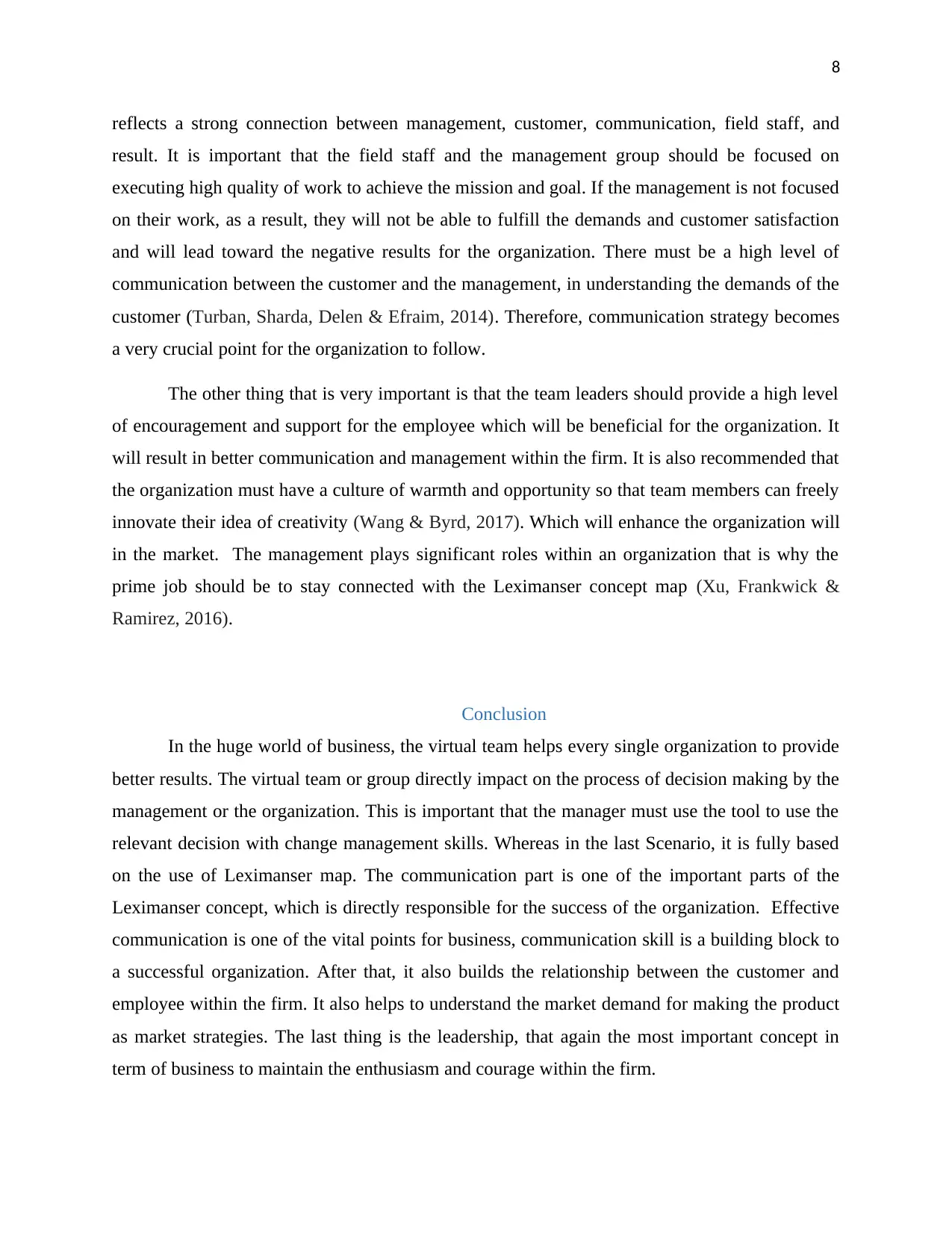
8
reflects a strong connection between management, customer, communication, field staff, and
result. It is important that the field staff and the management group should be focused on
executing high quality of work to achieve the mission and goal. If the management is not focused
on their work, as a result, they will not be able to fulfill the demands and customer satisfaction
and will lead toward the negative results for the organization. There must be a high level of
communication between the customer and the management, in understanding the demands of the
customer (Turban, Sharda, Delen & Efraim, 2014). Therefore, communication strategy becomes
a very crucial point for the organization to follow.
The other thing that is very important is that the team leaders should provide a high level
of encouragement and support for the employee which will be beneficial for the organization. It
will result in better communication and management within the firm. It is also recommended that
the organization must have a culture of warmth and opportunity so that team members can freely
innovate their idea of creativity (Wang & Byrd, 2017). Which will enhance the organization will
in the market. The management plays significant roles within an organization that is why the
prime job should be to stay connected with the Leximanser concept map (Xu, Frankwick &
Ramirez, 2016).
Conclusion
In the huge world of business, the virtual team helps every single organization to provide
better results. The virtual team or group directly impact on the process of decision making by the
management or the organization. This is important that the manager must use the tool to use the
relevant decision with change management skills. Whereas in the last Scenario, it is fully based
on the use of Leximanser map. The communication part is one of the important parts of the
Leximanser concept, which is directly responsible for the success of the organization. Effective
communication is one of the vital points for business, communication skill is a building block to
a successful organization. After that, it also builds the relationship between the customer and
employee within the firm. It also helps to understand the market demand for making the product
as market strategies. The last thing is the leadership, that again the most important concept in
term of business to maintain the enthusiasm and courage within the firm.
reflects a strong connection between management, customer, communication, field staff, and
result. It is important that the field staff and the management group should be focused on
executing high quality of work to achieve the mission and goal. If the management is not focused
on their work, as a result, they will not be able to fulfill the demands and customer satisfaction
and will lead toward the negative results for the organization. There must be a high level of
communication between the customer and the management, in understanding the demands of the
customer (Turban, Sharda, Delen & Efraim, 2014). Therefore, communication strategy becomes
a very crucial point for the organization to follow.
The other thing that is very important is that the team leaders should provide a high level
of encouragement and support for the employee which will be beneficial for the organization. It
will result in better communication and management within the firm. It is also recommended that
the organization must have a culture of warmth and opportunity so that team members can freely
innovate their idea of creativity (Wang & Byrd, 2017). Which will enhance the organization will
in the market. The management plays significant roles within an organization that is why the
prime job should be to stay connected with the Leximanser concept map (Xu, Frankwick &
Ramirez, 2016).
Conclusion
In the huge world of business, the virtual team helps every single organization to provide
better results. The virtual team or group directly impact on the process of decision making by the
management or the organization. This is important that the manager must use the tool to use the
relevant decision with change management skills. Whereas in the last Scenario, it is fully based
on the use of Leximanser map. The communication part is one of the important parts of the
Leximanser concept, which is directly responsible for the success of the organization. Effective
communication is one of the vital points for business, communication skill is a building block to
a successful organization. After that, it also builds the relationship between the customer and
employee within the firm. It also helps to understand the market demand for making the product
as market strategies. The last thing is the leadership, that again the most important concept in
term of business to maintain the enthusiasm and courage within the firm.
⊘ This is a preview!⊘
Do you want full access?
Subscribe today to unlock all pages.

Trusted by 1+ million students worldwide
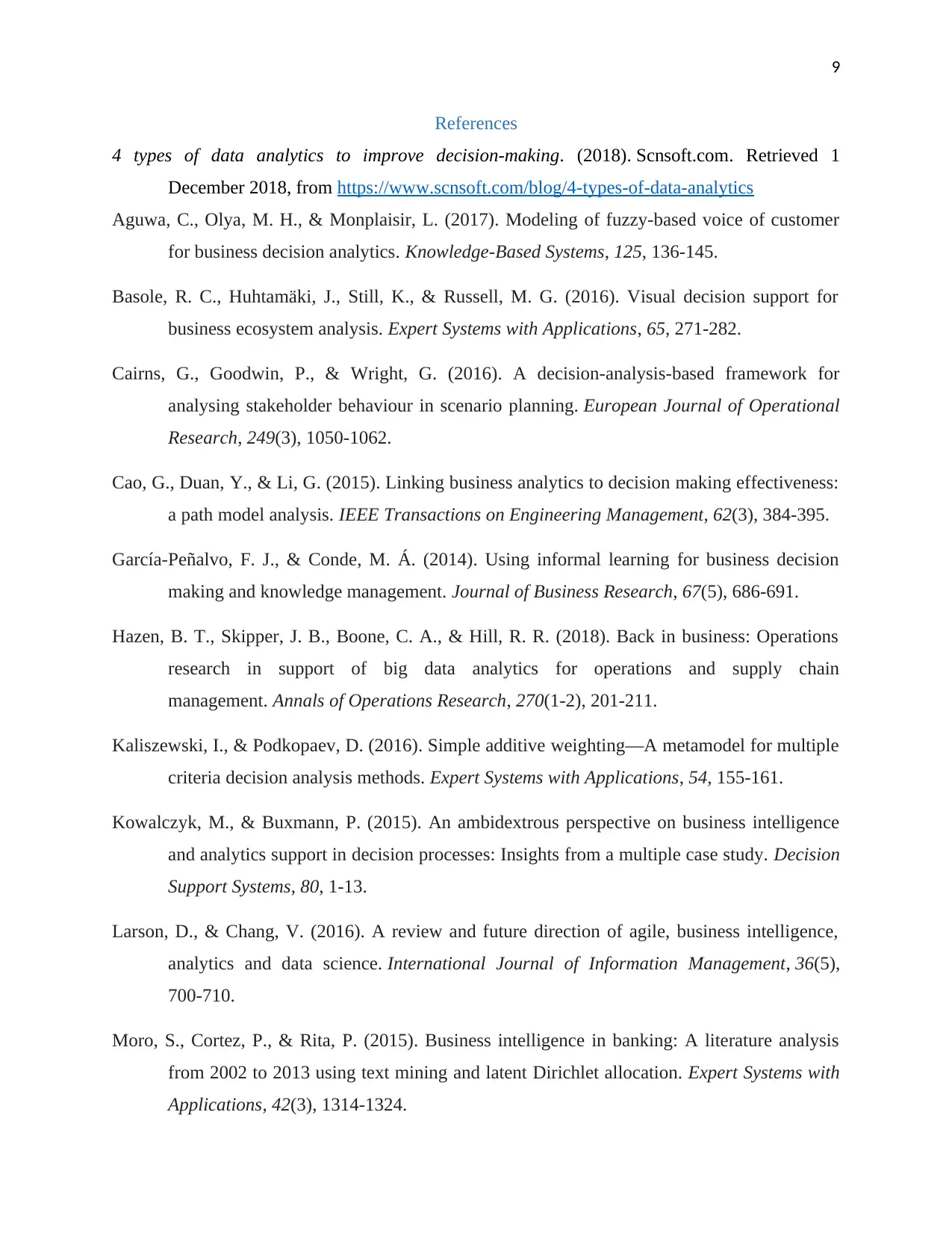
9
References
4 types of data analytics to improve decision-making. (2018). Scnsoft.com. Retrieved 1
December 2018, from https://www.scnsoft.com/blog/4-types-of-data-analytics
Aguwa, C., Olya, M. H., & Monplaisir, L. (2017). Modeling of fuzzy-based voice of customer
for business decision analytics. Knowledge-Based Systems, 125, 136-145.
Basole, R. C., Huhtamäki, J., Still, K., & Russell, M. G. (2016). Visual decision support for
business ecosystem analysis. Expert Systems with Applications, 65, 271-282.
Cairns, G., Goodwin, P., & Wright, G. (2016). A decision-analysis-based framework for
analysing stakeholder behaviour in scenario planning. European Journal of Operational
Research, 249(3), 1050-1062.
Cao, G., Duan, Y., & Li, G. (2015). Linking business analytics to decision making effectiveness:
a path model analysis. IEEE Transactions on Engineering Management, 62(3), 384-395.
García-Peñalvo, F. J., & Conde, M. Á. (2014). Using informal learning for business decision
making and knowledge management. Journal of Business Research, 67(5), 686-691.
Hazen, B. T., Skipper, J. B., Boone, C. A., & Hill, R. R. (2018). Back in business: Operations
research in support of big data analytics for operations and supply chain
management. Annals of Operations Research, 270(1-2), 201-211.
Kaliszewski, I., & Podkopaev, D. (2016). Simple additive weighting—A metamodel for multiple
criteria decision analysis methods. Expert Systems with Applications, 54, 155-161.
Kowalczyk, M., & Buxmann, P. (2015). An ambidextrous perspective on business intelligence
and analytics support in decision processes: Insights from a multiple case study. Decision
Support Systems, 80, 1-13.
Larson, D., & Chang, V. (2016). A review and future direction of agile, business intelligence,
analytics and data science. International Journal of Information Management, 36(5),
700-710.
Moro, S., Cortez, P., & Rita, P. (2015). Business intelligence in banking: A literature analysis
from 2002 to 2013 using text mining and latent Dirichlet allocation. Expert Systems with
Applications, 42(3), 1314-1324.
References
4 types of data analytics to improve decision-making. (2018). Scnsoft.com. Retrieved 1
December 2018, from https://www.scnsoft.com/blog/4-types-of-data-analytics
Aguwa, C., Olya, M. H., & Monplaisir, L. (2017). Modeling of fuzzy-based voice of customer
for business decision analytics. Knowledge-Based Systems, 125, 136-145.
Basole, R. C., Huhtamäki, J., Still, K., & Russell, M. G. (2016). Visual decision support for
business ecosystem analysis. Expert Systems with Applications, 65, 271-282.
Cairns, G., Goodwin, P., & Wright, G. (2016). A decision-analysis-based framework for
analysing stakeholder behaviour in scenario planning. European Journal of Operational
Research, 249(3), 1050-1062.
Cao, G., Duan, Y., & Li, G. (2015). Linking business analytics to decision making effectiveness:
a path model analysis. IEEE Transactions on Engineering Management, 62(3), 384-395.
García-Peñalvo, F. J., & Conde, M. Á. (2014). Using informal learning for business decision
making and knowledge management. Journal of Business Research, 67(5), 686-691.
Hazen, B. T., Skipper, J. B., Boone, C. A., & Hill, R. R. (2018). Back in business: Operations
research in support of big data analytics for operations and supply chain
management. Annals of Operations Research, 270(1-2), 201-211.
Kaliszewski, I., & Podkopaev, D. (2016). Simple additive weighting—A metamodel for multiple
criteria decision analysis methods. Expert Systems with Applications, 54, 155-161.
Kowalczyk, M., & Buxmann, P. (2015). An ambidextrous perspective on business intelligence
and analytics support in decision processes: Insights from a multiple case study. Decision
Support Systems, 80, 1-13.
Larson, D., & Chang, V. (2016). A review and future direction of agile, business intelligence,
analytics and data science. International Journal of Information Management, 36(5),
700-710.
Moro, S., Cortez, P., & Rita, P. (2015). Business intelligence in banking: A literature analysis
from 2002 to 2013 using text mining and latent Dirichlet allocation. Expert Systems with
Applications, 42(3), 1314-1324.
Paraphrase This Document
Need a fresh take? Get an instant paraphrase of this document with our AI Paraphraser

10
Nerkar, A. D. (2016). Business Analytics (BA): Core of Business Intelligence (BI). International
Journal of Advanced Engineering, Management and Science, 2(12).
Spacey, J. (2018). 7 Types of Decision Analysis. Simplicable. Retrieved 1 December 2018, from
https://simplicable.com/new/decision-analysis
Turban, E., Sharda, R., Delen, D., & Efraim, T. (2014). Decision support and business
intelligence systems (Vol. 9). Pearson.
Wang, Y., & Byrd, T. A. (2017). Business analytics-enabled decision-making effectiveness
through knowledge absorptive capacity in health care. Journal of Knowledge
Management, 21(3), 517-539.
Xu, Z., Frankwick, G. L., & Ramirez, E. (2016). Effects of big data analytics and traditional
marketing analytics on new product success: A knowledge fusion perspective. Journal of
Business Research, 69(5), 1562-1566.
Nerkar, A. D. (2016). Business Analytics (BA): Core of Business Intelligence (BI). International
Journal of Advanced Engineering, Management and Science, 2(12).
Spacey, J. (2018). 7 Types of Decision Analysis. Simplicable. Retrieved 1 December 2018, from
https://simplicable.com/new/decision-analysis
Turban, E., Sharda, R., Delen, D., & Efraim, T. (2014). Decision support and business
intelligence systems (Vol. 9). Pearson.
Wang, Y., & Byrd, T. A. (2017). Business analytics-enabled decision-making effectiveness
through knowledge absorptive capacity in health care. Journal of Knowledge
Management, 21(3), 517-539.
Xu, Z., Frankwick, G. L., & Ramirez, E. (2016). Effects of big data analytics and traditional
marketing analytics on new product success: A knowledge fusion perspective. Journal of
Business Research, 69(5), 1562-1566.
1 out of 11
Related Documents
Your All-in-One AI-Powered Toolkit for Academic Success.
+13062052269
info@desklib.com
Available 24*7 on WhatsApp / Email
![[object Object]](/_next/static/media/star-bottom.7253800d.svg)
Unlock your academic potential
Copyright © 2020–2025 A2Z Services. All Rights Reserved. Developed and managed by ZUCOL.




